Mary in the Councils
FREE Catholic Classes
By Deacon Keith Fournier
In 1987, Blessed John Paul II wrote his encyclical letter entitled â₏Ĺ"Mother of the Redeemer: On the Blessed Virgin Mary in the Life of the Pilgrim Church.â₏ It contains a wonderful summary of the teaching of the Church on the meaning, mystery and gift of Mary in the Plan of Salvation. It proceeds through the Scripture, the Sacred Tradition, the Church Councils, and the Magisterial teachings of the Church. The Holy father wrote: â₏Ĺ"With good reason, then, at the end of this Millennium, we Christians who know that the providential plan of the Most Holy Trinity is the central reality of Revelation and of faith feel the need to emphasize the unique presence of the Mother of Christ in history, especially during these last years leading up to the year 2000.
â₏Ĺ"The Second Vatican Council prepares us for this by presenting in its teaching the Mother of God in the mystery of Christ and of the Church. If it is true, as the Council itself proclaims, that 'only in the mystery of the Incarnate Word does the mystery of man take on light,' then this principle must be applied in a very particular way to that exceptional "daughter of the human race," that extraordinary "woman" who became the Mother of Christ. Only in the mystery of Christ is her mystery fully made clear. Thus has the Church sought to interpret it from the very beginning: the mystery of the Incarnation has enabled her to penetrate and to make ever clearer the mystery of the Mother of the Incarnate Word.
â₏Ĺ"The Council of Ephesus (431 AD) was of decisive importance in clarifying this, for during that Council, to the great joy of Christians, the truth of the divine motherhood of Mary was solemnly confirmed as a truth of the Church's faith.

The Madonna and Child with Saints - Domenico Veneziano - 1445
Mary is the Mother of God (= TheotĂÂłkos), since by the power of the Holy Spirit she conceived in her virginal womb and brought into the world Jesus Christ, the Son of God, who is of one being with the Father. "The Son of God...born of the Virgin Mary...has truly been made one of us," has been made man.
â₏Ĺ"Thus, through the mystery of Christ, on the horizon of the Church's faith there shines in its fullness the mystery of his Mother. In turn, the dogma of the divine motherhood of Mary was for the Council of Ephesus and is for the Church like a seal upon the dogma of the Incarnation, in which the Word truly assumes human nature into the unity of his person, without cancelling out that nature.â₏
The first four ecumenical Councils of the Church confirmed and defined Christian belief about the nature of God and the meaning of the Incarnation, saving life, death, ascension and resurrection of Jesus Christ. The Council pronouncements concerning Mary were made in reference to defending the truths about Jesus Christ and Godâ₏™s plan of salvation for the entire human race. That plan included, and still includes, the Mother of God.
The Catechism, in keeping with the unbroken tradition of the Church, makes the inseparable connection or link between the humanity of Jesus and the humanity of his Mother, as did Blessed John Paul in his encyclical letter cited above. The first four Councils of the Church, which are almost universally accepted among the broader Christian community even beyond the full communion of the Catholic Church, did the same. St. Gregory the Great (540-604 AD) once affirmed "I confess that I accept and reverence the four Councils as I do the four Gospels...for they are founded on universal consent."
The Councils affirmed the core of the Christian claim about who Jesus is and thus, who we can become in Him. The Council of Nicaea in 325 AD contended with a priest of Alexandria named Arius who taught that the Word or Son of God (who "became flesh and dwelt among us" as Jesus - Jn 1:14) was not God. Misusing passages in Johnâ₏™s Gospel (14:28) where Jesus proclaimed "the Father is greater than I" Arius denied that the Word of God, was eternal. The bishops at Nicaea considered all the texts of the Gospels (such as Jn 10:30: "I and the Father are one") under the guidance of the Holy Spirit and declared that Arius was in error. The Son or Word of God is God (see Jn 1:1) and always existed. This was memorialized in the Nicene Creed. They used a Greek word homoousios, which meant that the Word or Son is of the same "being" as God the Father. If the Father is God, so is the Son.
The struggle continued for fifty more years before the First Council of Constantinople (381 AD) reaffirmed the creed of Nicaea. This ecumenical council also felt it necessary to affirm the divinity of the Holy Spirit, the "Lord and Giver of Life" who with the Father and the Son "is worshipped and glorified" and that phrase was added to the Nicene Creed. In the fifth century there were two more councils that addressed questions about Jesus. In the early 5th century a prominent bishop, Nestorius, rejected the title "theotokos" or "God-bearer" as a proper term for Mary.
Christians had always affirmed that the mother of Jesus could rightly be called the "Mother of God" or "God-bearer" because the Gospels teach that Jesus was conceived by the Holy Spirit in Mary. Maryâ₏™s consent, her â₏Ĺ"Fiatâ₏ to the message of the Angel Gabriel (see Lk 1:26-38) was an essential element of the faith of the early Church, a model for all Christians. She was viewed as the â₏Ĺ"Second Eveâ₏ whose â₏Ĺ"Yesâ₏ untied the knot caused by Eveâ₏™s â₏Ĺ"Noâ₏.
A Bishop named Nestorius objected to the title of Theotokos, Mother of God or God Bearer for Mary. The Council of Ephesus met in 431AD and affirmed Mary was the "Mother of God" because she is the mother of God in his human nature which, because of the Incarnation, could not be separated from the divine nature. The Council also affirmed that Maryâ₏™s exercise of her human freedom, her assent, was a significant part of the plan of salvation, giving to the Incarnate Word, Jesus, the Second Person of the Blessed Trinity, his true and full humanity. When God the Holy Spirit "overshadowed" Mary the child born to her was truly God, the Son or Word of God (Lk 1:30-35).
After this Council, a monk, Eutyches claimed that before Jesus took flesh in Mary but that there were two "natures" - a divine and a human nature. After the union of the two natures in Maryâ₏™s womb, only one nature was left in Jesus - the divine nature. Eutyches essentially proposed that the divine nature swallowed up the humanity of Jesus. So Jesus only took on human appearance. The Cappadocian father, Gregory of Nazianzus, once proclaimed â₏Ĺ"whatever was not assumed was not healedâ₏. In that we understand the danger of the denial of the sacred humanity of Jesus. Redemption would not be complete.
The Council of Chalcedon in 451 AD dealt with this threat to the meaning and implications of the Incarnation of the Word of God. The creed of the Council of Chalcedon declared that Jesus Christ is one person who exists "in two natures" - a divine nature and a human nature - which are neither confused ("blended together" into a third nature) nor divided or separated. Jesus is fully God and truly and fully human. Thus, the first four ecumenical Councils defined the meaning of the most foundational belief of the Christian faith and, as a result preserved the great promise of that faith for each one of us. In these Councils, as in the Second Vatican Council, what was said about Mary ensured the continued proclamation of the fullness of the truth about Jesus Christ.
More Mary, Mother of God
Appearances of Mary
Apparitions and Appearances
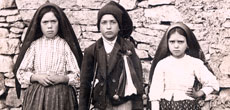
The term "appearance" has been used with Marian apparitions and visions of Jesus Christ. The Church will confirm an apparition as worthy of belief, but belief is never required by divine faith. Read More
Evaluating Apparitions
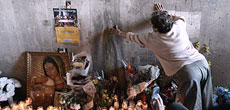
A Roman Catholic approved Marian apparition is one that has been examined by the Congregation for the Doctrine of the Faith and has been granted approval by the local Bishop or the Holy See. Read More
Approved Appearances
Vatican
Bishop
Coptic
Un-Approved Appearances
Unapproved Apparitions
Mary as Mother
Mother of God (TheotoKos)
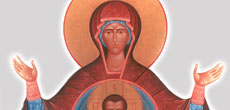
From antiquity, Mary has been called "Theotokos", or "God-Bearer". The word in Greek is "Theotokos". The term was used as part of the popular piety of the early first millennium church. Read More
Daughter of the Father

Mary is "full of grace," because it is precisely in her that the Incarnation of the Word, the hypostatic union of the Son of God with human nature, is accomplished and fulfilled. Read More
Mother of the Redeemer

Mary was there at the Incarnation, Birth, Crucifixion, and Resurrection of God Incarnate. She was there throughout the often called "hidden years" in Nazareth. In the life of the Redeemer... Read More
Spouse of the Spirit

Throughout God's relationship with Israel He promises to espouse His people to himself (See, e.g. Hosea 2:19). This language of spousal love, of nuptiality, is also present in this overshadowing... Read More
Mother of the Church
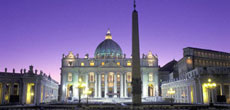
Since the Virgin Mary's role in the mystery of Christ and the Spirit has been treated, it is fitting now to consider her place in the mystery of the Church. She is acknowledged as... Read More
Mother of the Domestic Church

Mary is the mother of every domestic church, of every Christian family. She fully understands the naturally supernatural realities of family life because she lived them. Read More
Our Mother

I found that every one of the great influences in my Christian life from that communion of saints to which we are all joined was profoundly "Marian". Francis of Assissi, Bernard of Clairvaux... Read More
Mary as Model
Mary in the Scriptures

Christian Scripture calls the "more excellent way", the way of Love. Mary understands this Way and walked on it with extraordinary humility. Follow her in journey through the Scriptures. Read More
Mary in the Tradition

To understand Mary in the Tradition of the Church we have to understand what is meant by the word "Tradition" - and why it matters. In his second letter to the Thessalonians the Apostle Paul... Read More
Mary and the Councils

A Bishop named Nestorius objected to the title of Theotokos, Mother of God or God Bearer for Mary. The Council of Ephesus met in 431AD and affirmed Mary was the "Mother of God"... Read More
Mary in the Liturgical Year

The Second Vatican Council did not offer one particular document on Mary, the Mother of God. Rather, the Council fathers incorporated the meaning and mission of Mary, as well as her... Read More
Mary East and West
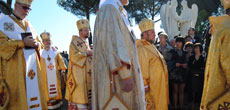
Devotion to - and love for . Mary, the Mother of God, is a foundational part of the Christian Church both East and West. The Eastern Christian emphasis, both doctrinally and devotionally, is... Read More
Mary and the Early Fathers

Among the multiple and profound references to Mary, the Mother of God, found in the writings of the early Church Fathers is one of my favorites in the Cappadocian, Gregory of Nyssa... Read More
Mary and the Saints

Among the titles given to Mary is "Queen of all the Saints". In one of his reflections on this woman whom he loved with such devotion, Blessed john Paul II proclaimed "This woman of faith... Read More
Mary as Disciple
Mary as Disciple

We were made to give ourselves away to the Lord and, in Him, for others. Mary's choice, her response to the invitation of a God, is a singularly extraordinary event in all of human history. Read More
Handmaiden of the Lord

"I am the handmaiden (servant) of the Lord; let it be to me according to your Word." (Luke 1:38) When Mary spoke those few words, human history was forever changed. Read More
Model of Holiness

From antiquity the early Christians reflected on a "mystery" of the faith- how the Incarnation of Jesus Christ came about through the free cooperation of this little Virgin of Nazareth... Read More
First Disciple
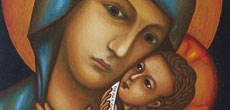
She was the first evangelizer and the first disciple of her Son Jesus. She gave the first Gospel testimony to her cousin, Elizabeth, without words, as the Redeemer in her womb drew the child in her womb... Read More
Way of Mary
The Message of Mary

And Mary said, "Behold, I am the servant of the Lord; let it be to me according to your word." And the angel departed from her. (The Gospel of Luke 2:34-37) Read More
The Meaning of Mary

"Behold, I am the handmaid of the Lord; let it be [done] to me according to your word." "At the announcement that she would give birth to "the Son of the Most High" without... Read More
The Prayer of Mary

Mary's Prayer teaches us to stay afloat in the ocean of life, with all of its undertows. Mary's way is to become an ark within, where the same God who became incarnate within her... Read More
The Song of Mary

"When Elizabeth heard Mary's greeting, the infant leaped in her womb, and Elizabeth, filled with the Holy Spirit, cried out in a loud voice and said, "Most blessed are you... Read More
The Titles of Mary

From the earliest theological reflections in Christian history we find the defense of the most important of the titles of Mary, "Theotokos" in Greek. It is translated God-bearer... Read More
Mission of Mary
Mary and the Eucharist

In a beautiful apostolic exhortation entitled the Sacrament of Love, issued in 1997, Pope Benedict XVI wrote these words under a section entitled The Eucharist and the Virgin Mary... Read More
Mary & the New Evangelization

Throughout his pontificate, Blessed John Paul II called for this "New Evangelization." Pope Benedict XVI made this a central pillar of his pontificate. He erected a Pontifical Council... Read More
The Path of Mary

Before they were called Christians (Acts 11:26), at Antioch, they were referred to as "the Way". A Rabbi named Saul spoke of persecuting "the way" (Acts 22:4) before he was profoundly converted... Read More
The Marian Moment

Over the last two decades a recovery of the significance of the life and witness of Mary has occurred among many Christians, even those who descend from the communities of... Read More
Mary's Mission

"Standing by the cross of Jesus were his mother... When Jesus saw his mother and the disciple there whom he loved, he said to his mother, Woman, behold, your son." Read More
Marian Prayer and Piety

Marian prayer and piety developed very early in the history of the undivided Christian Church of the first millennium. It has been kept alive in a myriad of piety practices in the both the Catholic... Read More
Message of Mary
What Does She Say?

The message of Mary is the message of the Gospel, to repent and believe the Good news. The message of Mary is conversion to Her Son by saying "yes" to God's invitation. That is the path to true... Read More
Marian Prayer and Devotion

The Catechism of the Catholic Church instructs the faithful on just how Mary prayed. Mary still prays. She has a special role in the plan of salvation and is a model for all Christians... Read More
Marian Consecration

To consecrate means to dedicate. It is used in reference to worship and means to be set aside or set apart for God. It is also a word which speaks to the very core of the Christian... Read More
Devotion of Mary
Sorrowful Mysteries of the Rosary

When they came to the place called the Skull, there they crucified him, along with the criminals - one on his right, the other on his left. Jesus said, "Father, forgive them... Read More
Joyful Mysteries of the Rosary

My soul magnifies the Lord, And my spirit rejoices in God my Savior; Because he has regarded the lowliness of his handmaid; For behold, henceforth all generations shall call me blessed... Read More
Glorious Mysteries of the Rosary

But at daybreak on the first day of the week they took the spices they had prepared and went to the tomb. They found the stone rolled away from the tomb; but when they entered... Read More
Luminous Mysteries of the Rosary

While he was praying his face changed in appearance and his clothing became dazzling white. And behold, two men were conversing with him, Moses and Elijah, who appeared in glory... Read More
Join the Movement
When you sign up below, you don't just join an email list - you're joining an entire movement for Free world class Catholic education.

-

- Stations of the Cross
- Easter / Lent
- 5 Lenten Prayers
- Ash Wednesday
- Living Lent
- 7 Morning Prayers
- Mysteries of the Rosary
- Litany of the Bl. Virgin Mary
- Popular Saints
- Popular Prayers
- Female Saints
- Saint Feast Days by Month
- Pray the Rosary
Palm Sunday and the Triumph of Humility and Hope
The Ascension of Jesus Christ: Our Hope, Our Glory
Do You Know Why Jesus’ Last Words Were: “It Is Finished”? (John 19:30)
Daily Catholic
 Daily Readings for Monday, April 14, 2025
Daily Readings for Monday, April 14, 2025 St. Lydwine: Saint of the Day for Monday, April 14, 2025
St. Lydwine: Saint of the Day for Monday, April 14, 2025 Daily Prayer to Guardian Angel: Prayer of the Day for Monday, April 14, 2025
Daily Prayer to Guardian Angel: Prayer of the Day for Monday, April 14, 2025 Daily Readings for Sunday, April 13, 2025
Daily Readings for Sunday, April 13, 2025 Pope Saint Martin I: Saint of the Day for Sunday, April 13, 2025
Pope Saint Martin I: Saint of the Day for Sunday, April 13, 2025- Prayer to be Faithful of Serving God: Prayer of the Day for Sunday, April 13, 2025
![]()
Copyright 2025 Catholic Online. All materials contained on this site, whether written, audible or visual are the exclusive property of Catholic Online and are protected under U.S. and International copyright laws, © Copyright 2025 Catholic Online. Any unauthorized use, without prior written consent of Catholic Online is strictly forbidden and prohibited.
Catholic Online is a Project of Your Catholic Voice Foundation, a Not-for-Profit Corporation. Your Catholic Voice Foundation has been granted a recognition of tax exemption under Section 501(c)(3) of the Internal Revenue Code. Federal Tax Identification Number: 81-0596847. Your gift is tax-deductible as allowed by law.








 Daily Readings for Monday, April 14, 2025
Daily Readings for Monday, April 14, 2025 St. Lydwine: Saint of the Day for Monday, April 14, 2025
St. Lydwine: Saint of the Day for Monday, April 14, 2025 Daily Prayer to Guardian Angel: Prayer of the Day for Monday, April 14, 2025
Daily Prayer to Guardian Angel: Prayer of the Day for Monday, April 14, 2025 Pope Saint Martin I: Saint of the Day for Sunday, April 13, 2025
Pope Saint Martin I: Saint of the Day for Sunday, April 13, 2025

